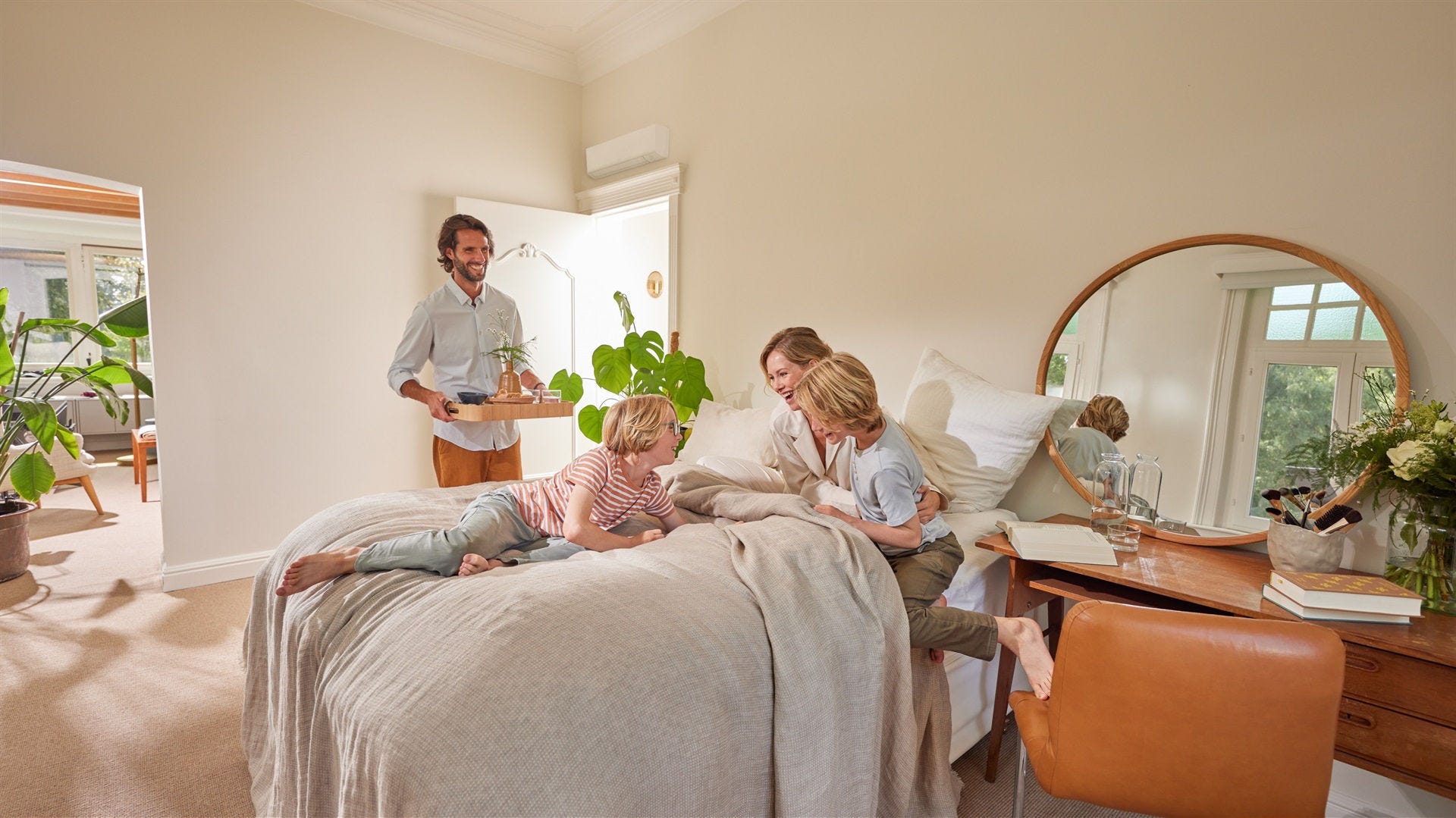Expert tips to clean your air conditioner step by step
Learn how to clean your air conditioner. We'll guide you through each step to help you maintain a cool environment and keep your system in optimal condition.

In today's world, where DIY is becoming increasingly popular, many people take pride and satisfaction in completing projects and tasks on their own. This trend not only offers the opportunity to save money, but also to acquire new skills.
Among the various activities we can undertake to improve our environment, cleaning the air conditioner is essential for maintaining a fresh, healthy atmosphere in our homes. Often underestimated, this task plays a crucial role in maintaining optimal air quality and prolonging the lifespan of these systems.
In light of the growing interest in preventive home maintenance, this article aims to explain the process to clean an air conditioner. However, it must be remembered that, while you can undertake this task on your own, it is always advisable to seek the expertise of a professional. A specialist not only has the necessary technical experience, but is also equipped with the right tools and products to ensure deep, effective cleaning.
What does this article cover?
Why is it important to clean the air conditioning unit?
- Better indoor air quality: Air conditioning filters trap dust particles, pollen, mites, viruses, and bacteria. Regular cleaning ensures these contaminants are eliminated, resulting in cleaner, healthier air to breathe. This is especially important for people with allergies, asthma, or respiratory problems.
- Energy efficiency: The cleaner it is, the better it works. Built-up dirt and residue can block system components, causing it to work harder and use more energy to maintain the required temperature. Energy efficiency is not only good for the environment, but can also save you money on energy bills.
- Prevent breakdowns and ensure a longer working life: A build-up of dirt can lead to component failures and significantly reduce the lifespan of the air conditioner. Regular cleaning prevents these problems, ensuring the equipment functions correctly for longer, avoiding costly repairs or replacements.
- Maintain a comfortable environment: A well-maintained air conditioning system ensures optimal performance and provides a fresh, pleasant environment. This is essential in both work and home environments, where thermal comfort contributes to overall well-being.

How often should the air conditioning unit be cleaned?
The cleaning frequency for an air conditioning unit is influenced by several factors, such as usage patterns and environmental conditions. For air conditioners in homes, the general recommendation is to carry out a check and clean at least once a year. This ensures that the equipment operates efficiently and maintains air quality in optimal conditions.
Increasing the cleaning frequency is recommended in places such as offices, where the air conditioner may be running almost all day. In this case, experts suggest cleaning every three to six months, depending on usage and the number of people sharing the space.
More frequent cleaning may be necessary in areas with high environmental pollution or in homes with pets (which can increase the amount of pet hair and dust in the environment), in order to prevent any obstructions and maintain air quality.
For ducted air conditioners, it is recommended to deep clean the ducts at least once a year. This is important in order to prevent any build-up of dust and other contaminants that can affect air quality and system efficiency.
Moreover, annual maintenance is recommended if the air conditioner is only used occasionally (2 to 3 times a week or at weekends). However, maintenance may need to be more frequent for equipment that is used more frequently.
It is important to remember that these are general recommendations, and specific cleaning requirements may vary depending on the air conditioning model and individual usage conditions. Referring to the user manual and following the manufacturer's instructions is always the best way to ensure proper maintenance.
How to clean the indoor air conditioning unit?
While this article aims to inform and educate you on cleaning your air conditioner, we also want to stress that it's best to leave these tasks to qualified professionals. This not only ensures the process is efficient and safe, but also gives you the peace of mind of knowing that your air conditioner is being expertly maintained, leading to a healthier environment and a longer working life for the appliance.
That said, let's get to work:
- Remove the grille and filters: Most air conditioning units have a front grille that can be easily removed. Behind this grille, you will find the air filters. Carefully remove them.
- Clean the filters: You can use an old toothbrush or a hand vacuum to remove any build-up of dust and dirt. If the filters are very dirty, you may need to wash them with water and a little mild detergent. Make sure they are completely dry before putting them back.
- Replace the indoor air filter: While regular cleaning can keep your air filter in good condition, it may nevertheless need replacing from time to time. Contact a professional if you feel it is necessary.
- Reassemble the unit: Once everything is clean and dry, you can return the filters and the front grille.


How to clean the outdoor air conditioning unit?
Cleaning the outdoor unit can be perilous as it is usually mounted on an outside wall. So remember: never clean your outdoor unit if it is mounted on an outside wall; call the official technical service instead. It's better to ask for assistance than to risk your life, don't you think? In any case, the process is as follows:
Visual inspection: Look for signs of damage or wear that may require professional intervention.
Clean the outside of the unit: Use a soft cloth or brush to remove any dust, cobwebs and other debris from the outside of the unit. This enhances its aesthetics and stops the ventilation grilles from becoming blocked.
Remove any leaves and debris: Leaves, branches, and other debris can often accumulate around and inside the outdoor unit. Remove them carefully in order to ensure an adequate airflow.
Before proceeding, please be warned that the following steps should be performed by a professional. They are complex and can damage the equipment if not done properly and with the right tools.
Check the drain pan: A clean tray will allow the condensation water to drain properly, avoiding any humidity problems or damage to the unit.
Check electrical connections and piping: While not strictly part of the cleaning process, a professional will ensure the electrical connections are secure and the pipes are free from leaks or damage.
Reconnect and test: Once the outdoor unit is clean and dry, the expert performing the maintenance and cleaning will reconnect the unit to the power supply and switch it on to ensure it is working correctly.
If you have purchased an air conditioner from Daikin, you can leave this entire process in the hands of our after-sales service. You will only have to register your system with Stand By Me to enjoy many benefits, such as one year of free maintenance. We'll also provide an annual check-up to ensure your equipment is always ready. Save time and worries with Daikin.
How to remove yellow stains from an air conditioning unit
If your air conditioning unit has turned yellow over time, you can try cleaning it with one of these two methods:
Hot water, bleach, and baking soda method: This procedure involves mixing 4 cups of hot water with bleach and baking soda. Once these ingredients are combined, use a spoon to stir the mixture. This method is useful for whitening the yellowish surfaces of the air conditioning unit, restoring its original appearance.
Use hydrogen peroxide cream: Another recommended home remedy involves using hydrogen peroxide cream. To apply the cream, first remove and clean any dust in the air conditioning unit. Wearing gloves to protect your hands, apply the hydrogen peroxide cream to the yellowish surface, covering with cling film if necessary. Hydrogen peroxide cream acts as an effective natural whitener.